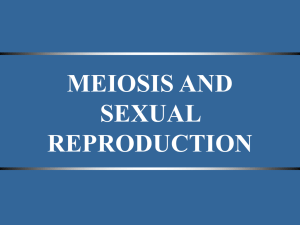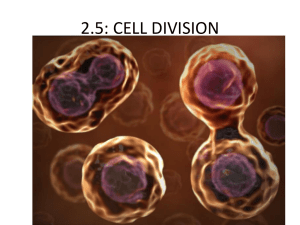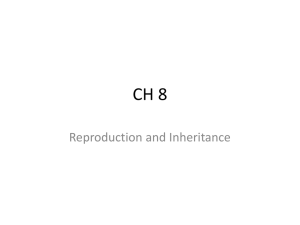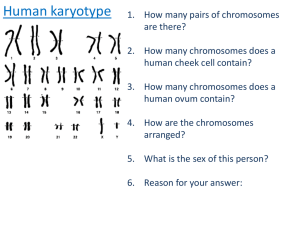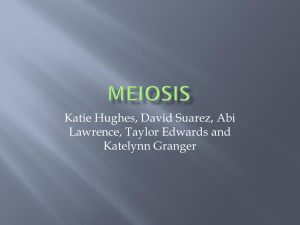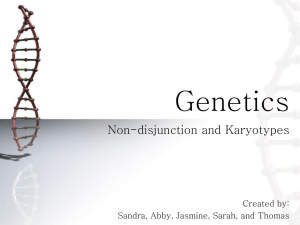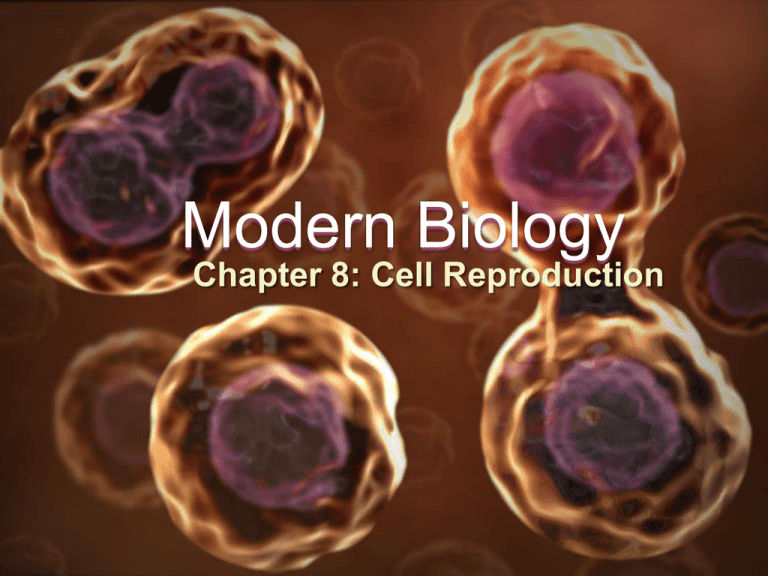
Modern Biology
Chapter 8: Cell Reproduction
8-1: Chromosomes
• Chromosome structure
– DNA coiled very tightly around proteins called
histones
3
4
chromosome
Sister chromatids
Centromere
8
Numbers of chromosomes…
Organism
Ant
Mosquito
Drosophila
melanogaster (fruit fly)
Human
Chimpanzee
# of chromosomes
2
6
8, with 6
autosomal, and 2
sexual
46, with 44
autosomal and 2
sexual
48
Organism
# of chromosomes
Ichthyomys pittieri
(semiaquatic rodent)
94 [highest for a
mammal]
Ophioglossum
reticulatum (fern)
1200 or 1260
[highest plant]
Aulacantha (protozoa) 1600 [highest]
C:\Projects\Holt-RinehartWinston\HRWScience\HRWScience\Modern_Biology\Ch08\60121.ht
ml
Chromosome numbers
• humans have 46 individual chromosomes in 23
pairs
• homologous pairs: each member of a pair
codes for the same trait, but may code for
different values of the trait
– both will code for eye color
– one may carry code for green, the other blue
Human Chromosome numbers
• of the 46 chromosomes,
–44 are autosomes
• autosome: non-sex chromosome
–2 are sex chromosomes
• sex chromosome: chromosomes that
determine the sex of an individual
Human sex determination
• XX- female
• XY- male
Female
Parent
Male
Parent
X
Y
X
XX
XY
X
XX
XY
Chromosome Number and Cell Type
• diploid cells
– diploid: cell that contain homologous pairs
– most cells in human body
– get one set from mom and the other from dad
– 2n
Chromosome Number and Cell Type
• haploid cells
– cell containing only one of each pair of
homologous chromosomes
– half the number of chromosomes
–n
– a.k.a.: gametes
• Sperm and eggs
Diploid v. Haploid
Haploid
Diploid
chromosomes exist in pairs Chromosomes don’t exist in pairs
Gametes
The
making of
an
individual
n (egg)
+ n (sperm)
2n (individual
with full
set)
Cell Division
For autosomal cells
Cell division in prokaryotes
• binary fission: division of prokaryotic cell into
two new cells
• produces genetically identical individuals
Binary
Fission
Cell division in eukaryotes
• the cell cycle: repeating series of events in
which new cells are made
• Has three main functions
Growth
Repair
Asexual
reproduction
Do we divide or
multiply?
A
Mathematical
Question
• http://www.youtube.com/watch?v=nPG6480R
Qo0&feature=related
• http://www.youtube.com/watch?v=nPG6480R
Qo0&NR=1
Dolly
• Dolly was the
first mammal to
be successfully
cloned.
Snuppy
Cloning gone very wrong…
• Activities
CELL DIVISION AND THE CELL
CYCLE
G0
cell that has exited the cell cycle
– nerve cells are permanently here
– they are unable to divide again
• Drugs and alcohol kill brain cells- it’s not a
myth
DO NOT DO STUPID
THINGS THAT KILL
THEM
• Actually, they kill all of your cells, brain
cells just don’t grow back.
Mitosis
•
•
•
M phase
Period of nuclear division
four phases
Anaphase
Metaphase
Late
Prophase
Telophase &
Cytokinesis
Early
Prophase
Interphase
(G1, S, G2)
Cytokinesis
• http://www.youtube.com/watch?v=4PKjF7Ou
mYo&feature=player_embedded#
CELL DIVISION STAGES
Prophase
•
•
•
•
•
DNA coils into chromosomes
Centrioles form
Spindle fibers come from centrioles
nucleolus and nuclear envelope disintegrated
longest of the phases
Prophase (early)
Metaphase
Anaphase
Telophase and
Cytokinesis
1
6
2
3
5
4
interphase
EARLY
prophase
LATE
prophase
HOW DID YOU DO?
metaphase
anaphase
interphase
CANCER- THE BASICS
CANCER
WHAT
CAUSES
CANCER?
A LOSS OF
THE CONTROL
MECHANISMS
Basic definitions
• Tumor: abnormal proliferation of cells that
results from a loss of control of mitosis
– Benign: pose no threat to the health of the
individual provided that they do not get so
large as to become a threat
– Malignant: uncontrolled cell division that
invades and destroys healthy tissue
Basic definitions
• Metastasis: spread of cancer cells beyond
their original site
– Allows the cancer to spread to other parts of
the body
Cancer and the cell cycle
• Cancer cells divide even when there is
inadequate room for new cells (hence a
dense tumor)
• Cancer cells divide when not attached to
the body (hence metastasis)
It typically takes multiple
mutations to cause cancer.
There is an entire spectrum of what cells may
look like, from normal to invasive dysplasia.
Metastasis
EXAMPLES OF CANCER
Lungs: non-smoker and smoker
Smoking facts you should know….
• The average smoker decreases his or her
lifespan by 17 years.
• Almost all first use occurs before high
school graduation.
• Roughly 6 million teens in the US today
smoke despite the knowledge that it is
addictive and leads to disease.
Facts you should know….
• Of every 100,000 15 year old
smokers, tobacco will prematurely
kill at least 20,000 before the age of
70.
• Of the 3,000 teens who started
smoking today, nearly 1,000 will
eventually die as a result from
smoking.
Facts you should know….
• Although only 5 percent of high
school smokers said that they would
definitely be smoking five years later,
close to 75 percent were still
smoking 7 to 9 years later.
Facts you should know….
• More than 90 percent of adult smokers
started when they were teens.
• The EPA has classified secondhand smoke as a
carcinogen since 1992.
• Every cigarette a man smokes reduces his life
by 11 minutes. Each carton of cigarettes thus
represents a day and a half of lost life. Every
year a man smokes a pack a day, he shortens
his life by almost 2 months.
Facts you should know….
• Nine out of ten smokers say they want to
quit.
• Cigarettes are the single-most traded
item on the planet, with approximately 1
trillion being sold from country to
country each year. At a global take of
more than $400 billion, it’s one of the
world’s largest industries.
Stages of Cancer
• Stage I: tend to be small and localized;
usually curable
• Stage II: tend to be locally advanced
• Stage III: tend to involve the local lymph
nodes
• Stage IV: metastasis
• Each type of cancer has its own very
specific guidelines for staging.
Colon Cancer
Rates of cancer
• Regular screening by yourself or a doctor
can sometimes help
– Small tumors that have not yet metastasized
are good candidates for surgical removal
– Chemo therapy or radiation therapy is an
attempt to kill the cancer cells before killing
the patient. (Cells that are dividing are more
susceptible to the affects than non-dividing
cells.)
Viruses and cancer
• Certain viruses can cause cancer in plants
and animals
• Many viral genes are oncogenes
• Viruses may suppress the tumorsuppressing genes
Cancer
• http://www.youtube.co
m/watch?v=VlN7K19QB0&feature=related
Cell Division
For reproductive cells
Meiosis I
Meiosis II
Prophase I
•
•
•
•
chromosomes condense
chromosomes arrange themselves with
homolog
tetrad: pair of homologous chromosomes
crossing over may occur (later section)
Metaphase I
•
•
•
spindle fibers attach
from each pole
tetrads line up along
midline
orientation of
homologous pairs is
independent and
random
Anaphase I
•
•
chromosomes migrate
to opposite poles
cells now haploid
Telophase I
•
•
•
chromosomes reach
opposite poles and
cytokinesis begins
cells are not
(necessarily) identical
nuclear membranes
form
Meiosis II
Prophase II
•
a. spindles reform
Metaphase II
•
a. chromosomes line
up along mid line
Anaphase II
•
chromatids separate
and move to opposite
poles
Telophase II
•
•
nuclear membranes form
cytokinesis occurs
Video
Formation of gametes
•
spermatogenesis
–
–
–
go through the above
and form 4 useable
cells
sperm
occurs in testes
throughout adulthood
of males
Note the
even
distribution
of
cytoplasm
Spermatogenesis
Video
Formation of gametes
•
oogenesis
– eggs
– a.k.a. ova (ovum- singular)
– uneven cytokinesis results in one useful cell and
3 polar bodies
– polar bodies degenerate and material can be
used again
Note the
uneven
distribution of
cytoplasm
Oogenesis
• Compare Mitosis and Meiosis
asexual reproduction
•
•
•
one parent
genetically identical offspring
budding
Sexual reproduction
•
•
•
two parents
genetically unique offspring
increases variation
Sexual
Reproduction
• http://www.youtube.com/watch?v=D1_mQS_FZ0
• http://www.youtube.com/watch?v=iCL6d0Ow
Kt8&feature=related





